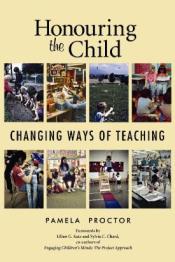
Thus I set pen to paper with delight,I had always wanted to be a teacher. I was seventeen when I left home to go to university and I was still only nineteen when, after two years of study, I started teaching in Vancouver. I enjoyed many aspects of the job but often found it quite taxing. Large numbers of children, little support for those most needy, the never ending tasks of teaching lessons in many subjects, plus the upkeep of appearances, that is--a beautiful classroom and quiet children--contributed to a heavy workload. However, my youthful enthusiasm carried me through so that after about five years, I had the planning and organization down pat. Feeling both self-assured and somewhat self-righteous, I applied to teach in England for a year on exchange. There, I was introduced to a very different approach. The approach seemed strange and I was slow to grasp it. I had worked hard to implement the ways I had been taught which I was sure were right. I once heard a story about two caterpillars crawling along in the grass. Both looked up into a tree where a beautiful butterfly was flitting from twig to twig. One said, "There's one thing I know for certain, you'll never catch ME up there." I was like that caterpillar. Concerned, confused and resistant to a different way of teaching, I was surprised when a spark of understanding started to take hold. Unwittingly, I had opened myself to change. At the same time, I was becoming aware of my own shortcomings. I began to realize how little I knew and how much there was to learn. Through subsequent studies at the University of British Columbia, team teaching in Vancouver's first open area school and working as a consultant, I became more informed. However, as I negotiated a steep learning curve, I found the struggle sometimes overwhelming. I often lay wide awake in the night trying to come to terms with the many ideas that were new to me. Eventually, with the ultimate in team-mates, I was fortunate to start a small school in the Vancouver system called Charles Dickens Annex. There, I changed my teaching style from teacher-centred to child-centred, from rigid to more relaxed. There, I became a more open and humane teacher. There, I was one of a team of three teachers at first, then five, seven, and finally nine without whose partnerships I would never have had the gumption to stay the course, even though it was my desire. I learned to have patience in the process of my unfolding. Jon Kabat Zinn writes about the importance of allowing time for change also using the analogy of a butterfly. Patience is a form of wisdom. It demonstrates that we understand and accept the fact that sometimes things must unfold in their own time. A child may try to help a butterfly to emerge by breaking open its chrysalis. Usually the butterfly doesn't benefit from this. Any adult knows that the butterfly can only emerge in its own time and the process cannot be hurried. ²The process heightened my awareness. In order to clarify my own thoughts, I began to reflect on my work. I recorded my observations and reactions as well as the ideas I gained from my reading. In doing so, I was a teacher who had by chance become a researcher, tracking my own progress. I was impressed by the degree to which our changed approach benefitted the children, as were other educators who visited the school. In response to requests, I began to give presentations about our work. With my colleagues, I gave workshops at conferences such as the annual B.C. Primary Teachers Conference, the Northwest Mathematics Conference, to university classes and to groups in other schools and school districts. However, to say all I needed to say I was inspired to write. To get started, I took part in a friend's master's degree study, for which I was to fulfill a long-held desire. Mine was to write an article for our primary teachers' journal, Prime Areas. After my first article was accepted, I wrote several more. Then, in 1981, while I was still teaching, I began to write the book you now hold. Even though it took a long time, I was motivated by the sense that parents and educators continue to face challenges, many of which I faced, and that for the sake of children, there is a need for change. In an article entitled Teachers as Learners, Dr. Lilian Katz asks the question, "How do experienced and effective teachers characterize their own developmental histories and the kinds of experiences that helped or hindered their development?" In this book I answer her question by describing my own progress in such a way that many other questions emerge, providing a basis for thoughtful discussion and action. To order this book please see Ordering Information
|
Home |
About the Author |
How to Order |
Latest News | Reviews |
|


